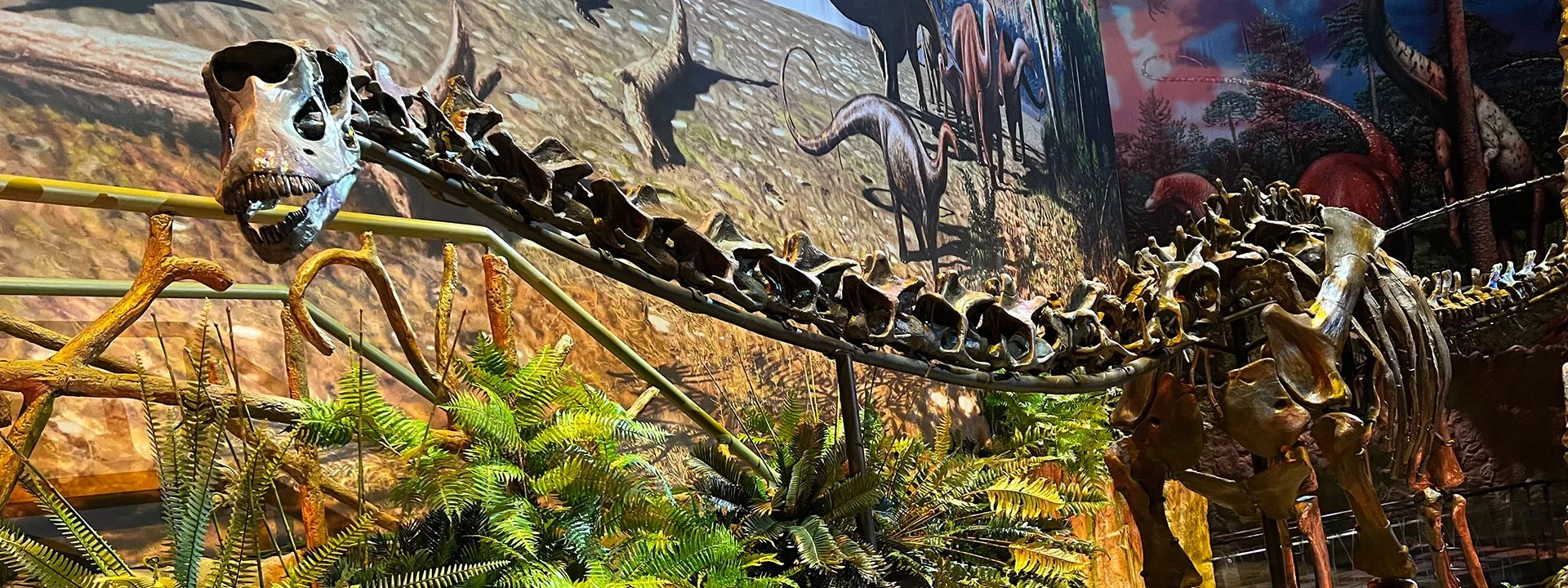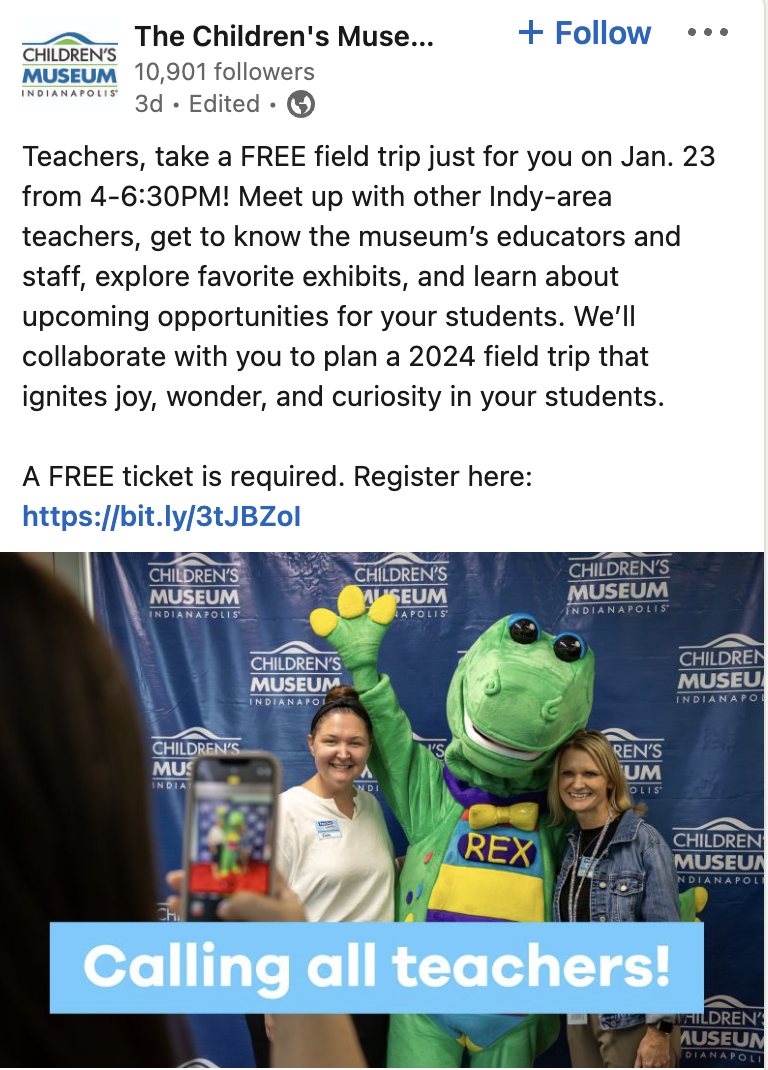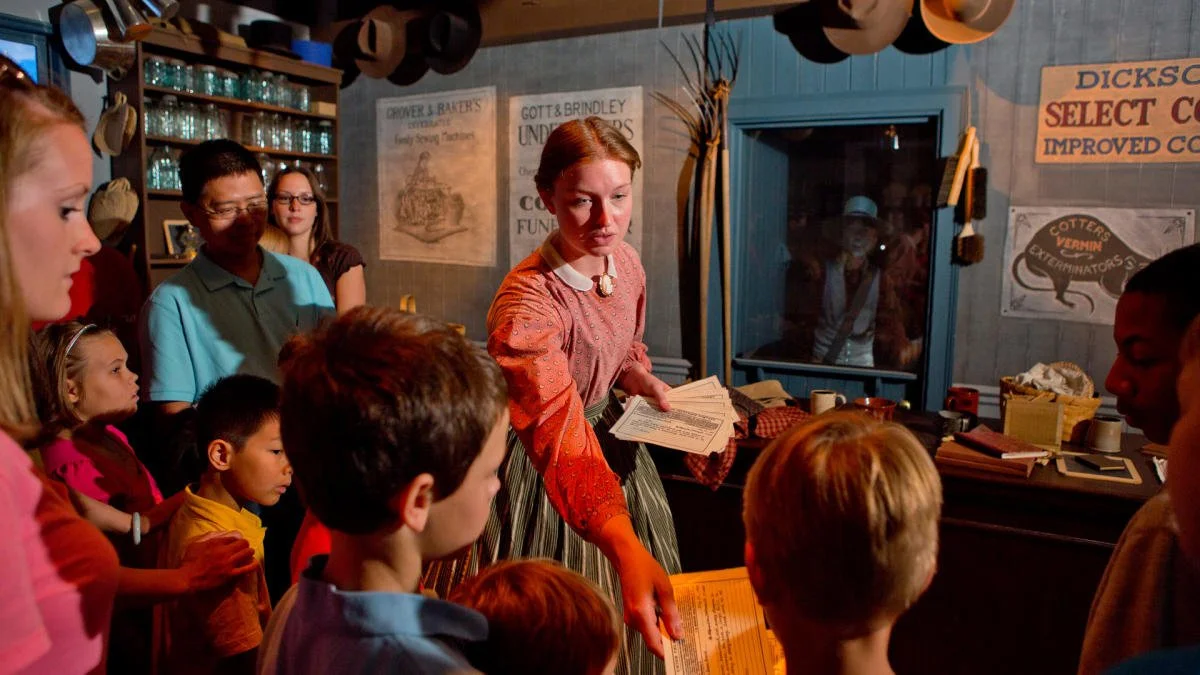Strategic Storytelling: Meagan Hook's Art of Crafting Social Media Connections
In the fall of 2023, I was able to chat with Meagan Hook and gain insight into how she successfully operates the social media channels for The Children’s Museum of Indianapolis. This is the world’s largest children’s museum and home to “five floors of fun” that welcome more than one million visitors annually. As the museum’s Manager of Social Media & Digital Content, she is responsible for organizing, creating, and implementing social media strategies across various social media platforms including Facebook, TikTok, Pinterest, Instagram, and more.
Throughout our conversation, I learned about Meagan's experience with social media and her ability to engage with the community in multiple ways virtually. After our conversation, I understood that a successful social media campaign needs to be properly planned out, each post must be intentional with a specific impact, and there must be trust between the museum and the content creator. In this blog, I’ll highlight each of these lessons along with insightful examples from Meagan’s personal experience.
Before I deep dive into our interview, I’d like to talk about Meagan’s familiarity with the digital world and how she landed her current position. In 2011 Meagan started working for a PR agency, posting on social media for events like restaurant openings. From there, she began writing captions for social posts and completing freelance work for a variety of clients ranging from car washes to escape rooms. This diversity of clientele allowed Meagan to master the practice of writing information and then translating it appropriately for different social media platforms.
When her current role opened up at the Indianapolis Children’s Museum, she couldn’t pass up the opportunity to apply. As part of the interview process, the museum asked applicants to take a Hogwarts acceptance letter (from the movie franchise Harry Potter) and generate an example of a social media post while using the museum’s voice.
Unlike other applicants, who developed just one post in response, Meagan took this opportunity to flex her skills and developed specialized content for each platform. By doing so, she demonstrated to the museum that a “one size fits all” strategy is not the most effective way to use social media. Her examples showed how marketing strategies can be more effective while delivering higher levels of customer value (Pelletier et al., 2020, p. 176). With this in mind, it’s no surprise that Meagan landed the job and has been happily employed at the museum for four years.
Although the museum does have a marketing department, Meagan is the only one in charge of social media. To keep social content organized, she created a master content spreadsheet that is color-coded according to categories like events, exhibitions, and education. This allows space for other people within the museum to propose an idea for posting and back it up with an impact. Her team also has a “content crew” that casually discusses upcoming topics and what the museum should be posting online.
As an example, Meagan’s team knows that there will be a solar eclipse happening in April 2024. She also knows that the museum has thousands of glasses available for people to use. Right now they are wondering, when should the museum start talking about it? What messaging should they use? Do they need a logo? (spoiler alert, peep the logo below). This type of open communication between departments is essential for museums to succeed in attracting visitors, building affinity, and connecting people to a mission (Dilenschneider, 2012). Planning like this also allows the museum to work with larger companies and pursue intellectual property that they may need to gain approval. Right now her team is already working on social content for March 2024, that’s five months ahead!
The museum’s logo for their eclipse extravaganza
Most of the museum’s content is pre-planned around reoccurring events or special exhibits, however, Meagan also likes to retain flexibility to allow for trending or socially relevant content. For posts that can be scheduled, she utilizes a platform called Sprout Social (non spon) which helps streamline the process so that she can schedule a batch of content at once rather than manually posting each piece of content multiple times a day.
This effective use of time management allows Meagan a lot of freedom in her position. She spends an average of two days in the museum while working the rest of the week planning, creating, and scheduling all from the comfort of her home. Her admirable organizational skills allow her to post for the Children’s Museum multiple times a week: an average of 1-2 days on Facebook, 3-4 days on Instagram, and 3 times a day on TikTok. Posting at this frequency on TikTok is essential for the museum to reach the younger audience that is reported to access the app every day, some even claiming to use the platform constantly (Vogels and Gelles-Watnick, 2023).
Top TikTok’s from the Children’s Museum of Indianapolis
One of the most important pieces of advice I gleaned from this interview is that every post on a social media platform should have a purpose. Meagan believes that the museum should not be posting just to put something out there. When she first started in her position, most of the museum’s posts seemed to be primarily “call to action” oriented. After a while, she says people started to scroll past these posts, which then affects how they react to future posts attempting to share value.
To retain engagement, her strategy is to allow one week of build-up to get the audience interested and then reveal the sale. This aligns with what Ryan Dodge, Chief Digital Officer at Canada’s Museum of Science and Innovation, says about social media use, “great content leads to dialogue which fuels reputation, which affects purchasing decisions” (Dodge, 2017). Being intentional with posts also means that not everything gets posted onto every platform. If the audience being targeted doesn’t spend time on a platform, then what’s the point? Ensuring that each post has a “why” attached to it allows her team to justify its need for being online so that she can successfully incorporate it into her schedule. One real-life example of this is that the museum posted about a teacher’s night only on LinkedIn because that’s where they knew the audience was.
A sample social media post from the museum’s LinkedIn account.
I believe Meagan’s success is also a result of the trust she’s earned with decision-makers at her museum. For many institutions, trending ideas or posts can get delayed in a funnel of approval while the viral moment rushes by. Trends moves too fast on social media to wait for approval before posting, especially on TikTok!
When she was first hired, most of the content Meagan created needed sign-off approval before posting. She gives credit to her direct boss for being a champion of her work and feels like she started to gain trust around nine months into the job. This is essential because a lack of trust has been shown “to be a barrier to online co-creation” (Pelletier et al., 2020, p. 281). Additionally, she continued to earn trust by utilizing Google Analytics, which revealed how effective her social advertisements were. Meagan also used UTM codes, which are additional text added to the end of a URL to track performance (Mineo, 2023). This allowed her to see each ticket sale that was purchased as a result of her social advertisements. This data provided a projection of ticket sales correlated to each future campaign and gave her the confidence to ask for a larger budget dedicated to social media.
As mentioned previously, social media is a space that requires flexibility due to each platform's ever-changing algorithms. When TikTok came around, the museum was unsure of its relevance in the space and was not initially committed to the app. Although not planning to create content, Meagan first heard about other organizations creating accounts in March of 2020 and wanted to reserve the official @ChildrensMuseum handle.
With the account created, Meagan was free to get comfortable with the app and see how other companies were using it. Then there came a moment when she decided it was better to ask for forgiveness rather than permission, and started posting. Soon she discovered an untapped audience and was blown away when the museum’s first viral video reached over 1 million views! By the time Meagan was ready to share the account with her team, she was able to show them all the content she’d created, the audience she was serving, and how well the content was already performing. I admire her for trusting her instincts and believe there was no other way to get everyone on board without the receipts to back it up.
These high-performing videos were all posted in one week
Because social media is constantly changing and evolving in real-time, it’s important to experiment now and then try to understand how best to reach an audience (Dilenschneider, 2013). It’s this mindset that also allows the museum to stay relevant with its offerings and exhibits. One of their most recent opportunities required moving a Barbie Jeep from storage into their lobby, providing a fun photo opportunity for guests.
Meagan Hook poses in the iconic Barbie Jeep
It took the collaborative effort of nine departments three months to get the approval to display the Barbie Jeep, which they received right before the opening weekend of the Barbie movie. Working with large companies always takes time, and the approval also came with a caveat that the museum wasn’t allowed to talk about the movie during the Jeep’s four-week display period. Meagan recalled how people would wait in line to take advantage of the picture-perfect moment, and they were encouraged to tag the museum in anything they posted online. I ultimately believe it was the combination of Meagan’s instinct, preparation, determination, and her team’s trust in her as a social media expert that made this event a success.
Meagan is a department-of-one, so she often looks to outside sources for inspiration regarding social media creation. A holy grail of advice can be found within a Facebook group she’s a member of which consists of museum professionals from around the country who do social media and online creation. Collaboration like this results in richer experiences for visitors by allowing creators to communicate and learn from each other (McLean, 1999, p. 100). Here she can participate in discussions happening in real time about apps, algorithms, social trends, and more.
Outside of this group, she gathers inspiration from brands like Scrub Daddy, Duo Lingo, The Walt Disney Company, Warner Brothers, and Six Flags. Sometimes her search for inspiration turns into collaborations with other museums, which can be instrumental in reaching new audiences. “Through this collaboration and cooperation, diverse networks grow that strengthen the role of the museum as a public institution and add an extra layer of intellectual rigor” (Kampschulte and Hatcher, 2021, p. 74). One notable collaboration that came up during our talk was when Meagan started a fake argument or “beef” with the Connor Prairie, an outdoor living history museum.
A snapshot from the living history museum
Before either museum posted anything online, the social media managers got together and approved each other's content (which made the two seem at odds with each other). After about a week of boasting that one museum was better than the other, each account posted videos revealing the fake feud to a highly invested audience. This type of creative marketing strategy is what catches people’s attention, and why Meagan has been so successful in growing the museum’s audience on TikTok to over 317K followers.
In conclusion, my conversation with Meagan Hook provided valuable insights into the world of social media management for museums. Her professional journey underscores the importance of adaptability and the ability to tailor content for different platforms. Her admirable organizational skills serve as a testament to the significance of strategic thinking in maintaining an engaging online presence.
Moreover, her willingness to experiment and her collaborative approach, including partnerships with other museums, reflect the dynamic nature of the digital landscape and the continuous quest for innovation. Meagan Hook's expertise and dedication have undoubtedly played a pivotal role in the museum's social media growth, proving that effective online engagement can catalyze connections, spark creativity, and ultimately, expand the reach and impact of cultural institutions in the digital age.
References
Dilenschneider, C. (2012, December 12). Social Media: The Every-Department Job in Nonprofit Organizations. Colleen Dilenschneider. https://www.colleendilen.com/2012/12/12/social-media-the-every-department-job-in-nonprofit-organizations/
Dilenschneider, C. (2013, July 18). 5 Key Reasons Why Social Media Strategies Are Different Than Traditional Marketing Strategies. Colleen Dilenschneider. https://www.colleendilen.com/2013/06/18/5-key-reasons-why-social-media-strategies-are-different-than-traditional-marketing-strategies/
Dodge, R. (2017). I am not a Social Media Guru. Museum Computer Network.
Kampschulte, L., & Hatcher, S. J. (2021, March 5). Changing Museums Through Cooperation and Collaboration, Journal of Museum Education, 46:1, 74-85, DOI: 10.1080/10598650.2020.1842046
McLean, K. (1999). Museum Exhibitions and the Dynamics of Dialogue. The MIT Press, 128(3), 83-107. http://www.jstor.com/stable/20027568
Mineo, G. (2023, June 1). UTM codes: How to create UTM tracking URLs on Google analytics. HubSpot Blog | Marketing, Sales, Agency, and Customer Success Content. https://blog.hubspot.com/marketing/what-are-utm-tracking-codes-ht
Pelletier, M. J., Krallman, A., Adams, F. G., & Hancock, T. (2020). One size doesn’t fit all: A uses and gratifications analysis of social media platforms. Journal of Research in Interactive Marketing, 14(2), 269-284. https://doi.org/10.1108/jrim-10-2019-0159
Vogels, E., & Gelles-Watnick, R. (2023, April 24). Teens and Social Media: Key Findings from Pew Research Center Surveys. Pew Research Center. https://www.pewresearch.org/short-reads/2023/04/24/teens-and-social-media-key-findings-from-pew-research-center-surveys/
Image Sources
Posted by The Children’s Museum on LinkedIn
https://blog.hubspot.com/marketing/what-are-utm-tracking-codes-ht
Posted by Meagan Hook on LinkedIn
https://www.visitindy.com/things-to-do/museums-attractions/conner-prairie/
Posted by Meagan Hook on LinkedIn
Posted by Meagan Hook on LinkedIn











